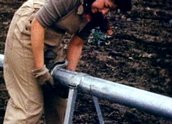


Thanks Girls and Goodbye (1988)
Synopsis
Thanks Girls and Goodbye is the story of the Australian Women’s Land Army which was set up during the Second World War to keep Australian farms producing food for the war effort. The film uncovers the amazing story of the women who volunteered to fill the boots of men who had left the farm to fight abroad.
This little-known story is told through the memories of the women who volunteered as well as the historical stills, news footage, home movies, letters and songs of their time on the land.
Curator’s notes
Thanks Girls and Goodbye is a gentle documentary about an extraordinary time in Australian history – the Second World War. Most importantly it documents Australian women’s wartime experience, largely overlooked before feminist historians and filmmakers started to explore it in the 1970s and ’80s.
Thanks Girls and Goodbye follows in the tradition of the landmark feature documentary, For Love or Money made in 1983 by Megan McMurchy, Jeni Thornley, Margot Oliver and Margot Nash. Both these films revealed a rich and fascinating history of women’s work in Australia.
By 1942 the Allied forces were desperate for food. They looked to Australia but men going off to war had depleted the workforce on the land. The answer lay in women taking their place so volunteers were recruited into the Women’s Land Army. These recruits were given a uniform but were not part of the official armed forces.
The film makes it clear that although these city girls were at first insecure about doing such hard work, most learnt to love the outdoors, the camaraderie among the women, and the sense of freedom that they experienced. For most of these women, their involvement was the experience of a lifetime, changing them forever. As Gloria Gear, ex-Australian Land Army, says in the film, 'I often think of it as the best part of our lives and yet so many people were dying. A bit of a paradox isn’t it?’.
When the war ended the men returned to their jobs and the Land Army women had to return home. But their expectations of themselves had changed. For many of the recruits the adjustment of moving from their jobs to the potentially more limited roles of wife and mother proved difficult. This was made all the more poignant when the RSL refused to recognise the Women’s Land Army along with the three official women’s armed services. Their contribution was ignored officially until 40 years later when they were finally allowed to march under their banner on Anzac day.
Thanks Girls and Goodbye refused the convention of using a narrator to tell its story. Instead, it uses a series of subtitles combined with interviews and historical footage. This can sometimes be difficult for the viewer since the historical footage is very entertaining and it is hard to interrupt the viewing by reading the information (see clip one).
The chronological structure of the story is divided into themes, which are then fleshed out by interviews, subtitles, personal stills and newsreels of the day. The atmosphere of hard work, fun and friendship is captured through the women’s voices and songs set against the heroic visuals of them working on the land. To add a visual consistency to the film all the interviews with the women were shot outdoors against orchards, vegetable patches and the bush (see clip two).
Thanks Girls and Goodbye is not just a 'feel good’ nostalgia film. It explores the reality of how the Women’s Land Army was exploited. Not only was the women’s contribution to the war effort not recognised until 1985 but the pay and conditions were second rate. One of the interviewees is Aboriginal activist Faith Bandler who, along with her sister Kath, served in the Australian Women’s Land Army working on fruit farms. Bandler describes how all the women were in the same boat in terms of poor pay and conditions but points out that Indigenous workers received even less pay than white workers. After being discharged from the army in 1945, she started to campaign for equal pay for Indigenous workers (see clip three).
Thanks Girls and Goodbye is an important film not only for its historical value but to remind us of the importance of equal access to the tools to be able to tell it. All the filmmakers involved in key creative positions in this film were women. One wonders whether this remarkable history would ever have been told, if it was not for the women’s liberation movement and Aboriginal activists like Faith Bandler.
The co-producer, writer and director, Sue Maslin (with Sue Hardisty), has gone on to produce award-winning feature films Road to Nhill (1996), Japanese Story (2003) and the feature documentary Hunt Angels (2006).
Thanks Girls and Goodbye was theatrically released by Ronin Films in Australia on 30 November 1988. It screened at the Melbourne Film Festival in 1988 and was broadcast on ABC Television on 25 February 1991.
- Overview
- Curator’s notes
- Video 3 clips
- Principal credits
- Find a copy
- Make a comment
- Map
- Add your review



